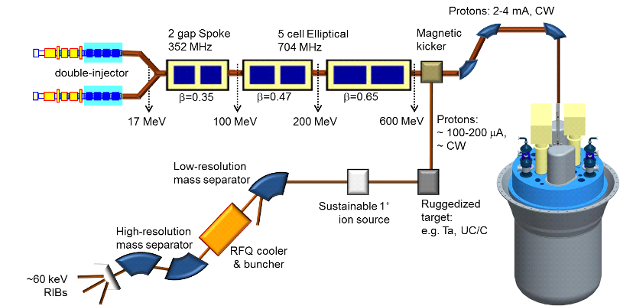Molecular beams and the ISOL@MYRRHA Pb-Bi target
Molecular beams and the ISOL@MYRRHA Pb-Bi target
Promotor(en): S. Cottenier, L. Popescu /15_MAT05 / Solid-state physicsYou may have heard about the MYRRHA reactor, which is being developed at the Belgian nuclear research center SCK-CEN in Mol (http://myrrha.sckcen.be). MYRRHA is a so-called “accelerator-driven system” (ADS): a reactor that does require an external proton beam in order to sustain a fission reaction. This makes it impossible to have, for instance, a Fukushima-like meltdown: in case of problems the accelerator is turned off, and the fission reactions terminate spontaneously. This master thesis project is not about MYRRHA, but about a second facility called ISOL@MYRRHA that is under consideration to be built next to MYRRHA, and which will make use of the same intense proton beam during every fraction of a second when MYRRHA does not need it. This second facility is an Isotope Separator On-Line (ISOL), with the purpose to generate Radioactive Ion Beams (RIB) that can be used for a variety of applications in nuclear research, materials science and biological studies.

The target material that is put into the proton beam determines which radioactive isotopes are produced. An important activity is therefore to develop suitable targets that allow the ISOL facility to produce a variety of RIBs. One of the targets that is under development for the ISOL@MYRRHA facility, is a loop-type molten Lead-Bismuth Eutectic (LBE) target. Major assets of this target are its ability to operate under high primary beam power conditions while allowing access to short-lived neutron-deficient isotopes in the vicinity of the target nuclides. Indeed, mercury (Hg) and polonium (Po) isotopes are more volatile than the target elements lead (Pb) and bismuth (Bi) and can be extracted from the target as single elements. On the other hand, gold (Au) and platinum (Pt) isotopes are less volatile and substantial amounts of these isotopes cannot be extracted in single-elements form.
A technique that has been studied and implemented in ISOL targets to circumvent the lack-of-volatility issue of some elements is the release of these elements in molecular compounds instead of single elements (the “molecular sideband” in the jargon of ISOL targets). This thesis aims at developing a new target that makes use of this approach.
Goal The goal of the present master thesis project is to identify potential sideband elements for the production of Au and Pt in molecular form out of a molten LBE target. The different stoichiometric states of these molecules will be compared to the single-element state with respect to volatility and reactivity with the target container material. This will be done in the first place by quantum simulations (density-functional theory and related methods), as in this way it is easy to examine a variety of situations. In follow-up work, the most promising cases will be examined experimentally.
For each of the desired product elements (Au and Pt), a literature study will first determine a set of elements with chemical affinity. Chemical reactions of these elements with Au and Pt will then be tested numerically to determine the most probable states of the reaction products.
By comparing for each product element the volatility and reactivity of the elemental and molecular states it will be possible to determine which state is the most efficient one for release of Au and Pt out of a molten LBE target.
These results will then enable isotope-release calculations in order to estimate the gain in delay time and efficiency for a molecular release of Au and Pt isotopes out of the loop-type molten LBE target of ISOL@MYRRHA.
This master thesis will be performed as a close cooperation between the Center for Molecular Modeling (providing expertise on the molecular simulations) and the SCK-CEN (providing expertise on ISOL target development).
- Study programmeMaster of Science in Engineering Physics [EMPHYS], Master of Science in Physics and Astronomy [CMFYST]ClustersFor Engineering Physics students, this thesis is closely related to the cluster(s) Modelling, nano, nuclear

